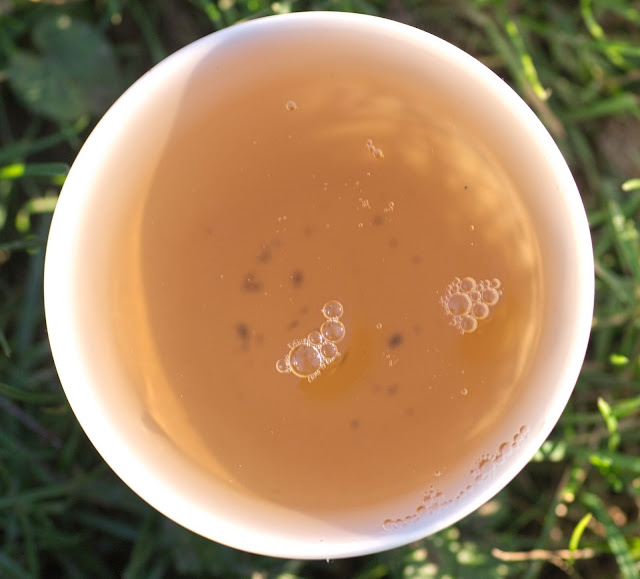Hi again! Apologies for be silent for so long. I am genuinely fascinated by the fact I'm still getting a lot of reads even though I haven't written anything new in ages. I've even got quite a lot of notes on the teas I'm drinking written briefly, but the final bit of compulsion to post them was missing - maybe this will change, who knows.
Now, recovering after a draining stint of lab experiments, when real life is slowly coming back to me, I felt like sitting out in the garden with a cup of tea again, which is a positive change to the most common pattern, where I'd drink tea alongside work, book, or music, but not that often purely with tea.
Before we get to the tea itself, let me show you a new cup/chawan I have - I find it absolutely lovely - it's a sort of parting gift from my main supervisor (made by his wife), when he left Oxford for a better place (that wasn't poetic, he's still alive, of course!). While I do miss his cheerful and super-stimulating presence, in times of Skype and e-mail, the DPhil studies are not really hampered... Netting me a +1 teacup. It's funny, I wouldn't have hoped for such a practical and pretty cup (as pretty as if I dreamed it out, honestly) - it may not be obvious from the photographs, but it's a really personal thing now - and the countless fractal-like details in it gave me hours of enjoyment already from watching alone.


Anyway, tea tea tea... I'm certainly not getting rusty in tea drinking (well, maybe I am, given the rusty patina that has a tendency to attach itself to everything tea touches). Aside from gallons of puerh, I had the pleasure to drink many teas from Darjeeling, via Vadham tea, recommended by Hster of teacloset. I particularly enjoyed Dharamsala Mann teas - premium, and the handmade more-premium version that is not available anymore. These teas combine the sharp fruitiness of first-flush Darjeeling, with strong grassiness (and a bit of marijuana aroma - I don't smoke anything, but I don't mind smelling it in streets, this reminded me of it), which I found extremely refreshing and stimulating.
Anyway, the biggest discovery in the world of tea would be, for me, the range of 2015 Wuyi teas offered by Chawangshop. My issue with many Wuyi oolongs was that they were great, but expensive (Essence of tea), or underwhelming (pretty much all the other ones I've tried). Chawangshop's Wuyi selection seems to be great, but not as expensive ($8-25 per 50g or so...). Every single of those is worth discussing, but today, I'll focus at the 2015 Handmade Rou Gui.
The dry leaves smell so nice when you open the bag - it's a full, deep, sweet aroma, a mixture of dry fruits, without an excessive fire aroma (which is often a problem; mediocre materials seems to be often overbaked to cover up the underlying lacklusterity).
In mouth, this tea is one of those "hell yeah"-with-a-content-smile ones. It's very thick and making the whole body feel one is drinking it, giving a feeling of concentration around solar plexus (I swear I don't have a second job for those magazines writing about third eye, illuminati controlling our lives, etc.). In this aspect, I find the tea almost a "partner" in drinking. With normal tea, you just drink it, right? This one definitely responds and let's you have his opinion on the session too!
The strength of feeling makes the taste secondary to me, initially, but when it emergess, it's also totally there. It's definitely opulent, rich, and deep: sweet, tasting of dried fruit, cinnamon, and a bit of fire, but not much (and definitely not TOO much). After several seconds, a noble aftertaste arrives, bringing tastes like oak, malt, and "fiery rocks" (I totally had flashback of drinking Jura whisky there).
I find no flaw in this tea. It isn't the most unusual Wuyi oolong for sure, rather sticking to its core concepts, but still, it does what it does so well that I cannot but love it. It could last more steepings, I guess, but then that's just me being greedy I suppose.
See you all soon, I hope! By the way, I have a question for you as well - when I was briefly looking at blogs that used to be active "back in the good old times", it seems that most of them are similarly dead as mine was... is it really the case? Are there new great blogs sprouting, taking over the older ones? Let me know if there are some good ones, please.
















